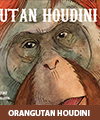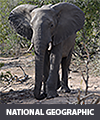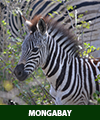
Orangutan Houdini Author's Note
While the main events of this story are true, some details are guesses.
Fu Manchu's escapes first occurred in October 1968 at the Henry Doorly Zoo in Omaha, Nebraska. The escapes included here were not his first. Fu used to open up his chain-link fence and let everybody out. He’d also twist off padlocks, forcing staff to use heavy-duty models and cover them with stainless-steel plates. Typically, after an escape, Fu would sit by the building and wait for his keepers.
Other zoo orangutans have also escaped, including Karta at Australia’s Adelaide Zoo and Ken Allen at the San Diego Zoo, who had his own fan club.
These escapes provide insights into the cognitive ability and intelligence of orangutans. In the classic book Animal Tool Behavior, primatologist Benjamin Beck compared tool use among the great apes. He noted that, if a screwdriver was left in a cage, a gorilla would ignore it, a chimpanzee would use it for everything but its intended purpose, while an orangutan would notice it immediately “but ignore it lest a keeper discover the oversight.” If the tool remained unnoticed, the orangutan would wait until night and then pick the locks or dismantle the cage and escape.
Escapes like Fu’s demonstrate an orangutan’s ability to deceive, which shows significant mental abilities. Fu had to understand Jerry’s behavior and predict that, if Jerry found the wire, the keeper would take it away. He then had to decide to outwit Jerry and devise a plan to conceal the tool. That meant Fu had to analyze potential hiding places given Jerry’s likely behavior and reject those that were too risky.
Fu also had to “reverse-engineer” the lock and design a tool to open it. With that design in mind, he needed to obtain the necessary materials and construct it in a way that would work and that he could hide from view.
Fu was special to all who knew him. When young, he would slide inside a keeper’s parka, wiggle his arms down the sleeves (so that both were inside) and then play with the keeper. When older, he would take his keepers’ hands and make them pat their heads, rub their bellies, and slap their faces.
Fu never hurt a soul. On at least three separate occasions, he rescued keepers who were getting chewed up or bitten by attacking orangutans. He also saved a curator who, while trying to catch a young orangutan, slipped on the wet floor. The curator stuck out his hand for balance and inadvertently put it inside an electrified plate-glass window. (The glass was electrified to prevent the orangutans from finger-painting on it.) As the man lay on the floor, Fu made sure he was okay and then took the man’s right index finger and ran it down the three-quarter-inch bare strip between the glass and the frame, the one place that could be touched without harm—as if showing him how to avoid future problems.
For years, the Henry Doorly Zoo displayed Fu’s American Association of Locksmiths honorary membership plaque on the wall as a tribute to the ape’s ingenuity.
His antics have been documented in books and articles, including Eugene Linden’s The Parrot’s Lament and The Octopus and the Orangutan; Aline Alexander Newman’s Ape Escapes; “Can Animals Think?” in Time (August 29, 1999); and “Animal Minds” on WNYC’s Radiolab (January 25, 2010).
Fu eventually moved to the Gladys Porter Zoo in Brownsville, Texas, not because of his escapes but to prevent hybridization. (Fu was a Sumatran orangutan, and the others were Bornean.) Jerry moved to that same zoo where he is currently facilities director.
Fu Manchu passed away in the late 1990s.
For Media Inquiries, Events, Speaking Engagements and School visits:
Twitter: @LaurelNeme
https://www.facebook.com/LaurelANeme/
She specializes in bringing together diverse perspectives — from farmers and indigenous groups to high-level policymakers — to create positive solutions that protect wildlife while improving the livelihoods of those living near the animals.




